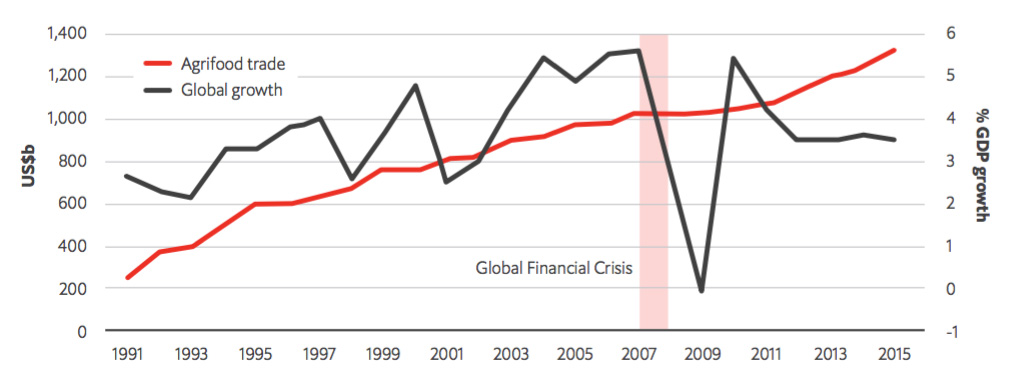Remote work is here to stay
Related content

Will the covid-19 pandemic accelerate automation?
Workers in developing countries are already jittery with worries ranging from “rebound” outbreaks and lay-offs to the onset of cabin fever.
As if workers don’t have enough on their minds, the covid-19 pandemic is resurfacing another concern: the one about technology’s impact on the future of work. Specifically, recent research suggests that the deepening recession is likely to bring a surge of labour-replacing automation.
But what’s the connection between recessions and automation? On the surface, the implacable infiltration of automation into the economy would seem to be a steady, longer-term trend rather than an immediate fact. Likewise, it might seem intuitive that any rise in unemployment in the coming months will make human labour relatively cheaper, thus slowing companies’ move to technology.
Yet that’s not actually how automation works. Unfortunately for the workers poised to be affected, robots’ infiltration of the workforce doesn’t occur at a steady, gradual pace. Instead, automation tends to happen in bursts, concentrated especially in bad times such as in the wake of economic shocks when humans become relatively more expensive as firms’ revenues rapidly decline. At these moments, employers can benefit by shedding less-skilled workers and replacing much of what they do with technology, while often investing in higher-skilled workers, which increases labour productivity as a recession tapers off.
Ultimately, such cycles of workforce reallocation may well improve the efficiency of the economy for the longer-term good of society. But along the way, and in the nearer-term, such cyclical surges of technology adoption tend to be disruptive, unequal and unhelpful to the cause of maintaining employment during a crisis.
Nor are these disruptions only speculative. Several economists have extensively documented the cyclical, selective nature of automation and employment disruption. Nir Jaimovich of the University of Zurich and Henry E. Siu of the University of British Columbia have reported that over three recessions in the past 30 years a whopping 88% of job loss took place in “routine”, highly automatable occupations—suggesting that automation accounted for “essentially all” of the jobs lost in the crises. Separately, Brad J. Hershbein of the W.E. Upjohn Institute and Lisa B. Kahn of the University of Rochester looked at almost 100m online job postings before and after the Great Recession and found that firms in hard-hit metropolitan areas were steadily replacing workers who performed automatable “routine” tasks with a combination of technology and skilled workers. So, even as robots replace workers during boom times at places such as Amazon and Walmart, their influx surges during recessions—not great news for the world’s anxious workers.
Given the importance of social distancing and sanitation it seems likely that the coronavirus recession will see an accentuated embrace of automation technologies, whether in the form of kiosk ordering in restaurants, checkout-free shopping or robotic sanitation machines. Considering that the past decade has seen more automation and artificial intelligence (AI) applications readied for effective use than ever, it seems clear that the next few years will see more rather than less automation as the economy slows.
Cyclical surges of technology adoption tend to be disruptive, unequal and unhelpful to the cause of maintaining employment during a crisis.
As to who may be vulnerable to automation-related dislocation in the recession, the reach of technology may be wider this time round.
As my 2019 assessment of US automation trends suggests, it’s likely that low-income workers, the young and workers of colour will be some of the most vulnerable. That’s because the epidemic and subsequent automation surge is likely to affect the most “routine” occupations—jobs in areas such as production, food service or transportation.
And yet that is only part of the story. During this crisis, AI may play a larger role than before as an array of algorithmic applications take on countless office functions that would be said to require higher-level “intelligence”, whether it be planning, predicting, classifying, reasoning or problem-solving. In that vein, assessments developed by Stanford scholar Michael Webb in partnership with my team suggest that if AI surges further into the economy during the crisis it may affect better-paid, white-collar or professional workers more than the less-educated, lower-wage workers who have tended to be most affected by robots and software.
Workers in higher-wage occupations will generally be more exposed to AI than lower-wage workers. The curve tapers at the 90th percentile, suggesting that the most elite workers—such as CEOs—may be somewhat protected.
That doesn’t mean that the world’s white-collar workers should all be fearing for their jobs. But it does mean that the relatively more fortunate “telework” class—market research analysts, middle managers, programmers or financial analysts—could also find themselves more involved with new and disruptive technologies. In that sense, no group of workers may be entirely immune this time around.
As to what all of this means for the future, the potential for a covid-19 automation surge reinforces the fact that the pandemic recession won’t just bring an end to a decade of plentiful jobs. More starkly, the downturn is likely to usher in a new bout of structural change in the labour market and its demand for skills.
If it continues for a while, the downturn could induce firms in food service, retail and administrative work to restructure their operations towards greater use of technology and higher-skilled workers. And it could introduce new waves of “digital transformation” into the world’s offices. From beleaguered, lower-skilled employees to professional workers, these changes will no doubt complicate an already daunting return to normality.
Mark Muro is a senior fellow at the Brookings Institution in Washington, DC.
The views and opinions expressed in this article are those of the author and do not necessarily reflect the views of The Economist Group or any of its affiliates. The Economist Group cannot accept any responsibility or liability for reliance by any person on this article or any of the information, opinions or conclusions set out in the article.

How covid-19 could bring about new social contracts around data
Data has become a crucial battleground in the war against coronavirus, as many countries have used sophisticated methods for gathering and analysing information on individuals’ behaviour to monitor and manage the pandemic.
This could lead to a lasting shift in how we think about data and its governance. Here I set out what a new social contract around data might consist of—and how might move beyond the frustrating vagueness that has characterised much of the debate so far.
The binary debate of the 2010s
For the past decade the public discourse around data has been squeezed into a binary framework. On one side were big organisations—governments and large companies—harvesting data on an unprecedented scale. They provided little transparency or consideration for privacy—but demonstrated benefits in valuable products and services. Against them grew activists who argued for new rights and restrictions to put data under the control of citizens.
Covid-19 has now shown the limits of both data hubris and data restriction. Smart use of data from multiple sources can undoubtedly be in the public interest. But it’s clearer than ever that strong rules will be needed to prevent the abuse of power.
We may be headed towards a new social contract around data that combines three distinct elements: first, new norms of data minimisation and privacy by design; second, strong laws to punish abuses; and third, a new generation of regulators and institutions charged with maximising the public value derived from data. If we can get this right, we’ll see radically more data sharing where there is a public interest in doing so, and less where there isn’t. But the details will be all-important.
Innovations in the crisis
The prompt is the extraordinary innovation fuelled by the crisis. China moved first, using mobile phone data to track the millions who left Wuhan in the hours before the city was cut off. Alipay and WeChat’s HealthCode (which also drew on self-reporting and medical records) were then used to give people red, yellow or green status to determine their freedom of movement depending on whether they had been near infected individuals. Taiwan also used mobile phone data to track people who had been infected and manage their quarantines.
Singapore relied on a combination of its TraceTogether app and teams performing investigations and interviews to determine who needed to be tested. South Korea used smartphone data, credit card payments and other sources to trace contact between individuals (and sparked controversy when transparency about people’s travel patterns uncovered illicit affairs).
Covid-19 has shown the limits of both data hubris and data restriction. Smart use of data from multiple sources can undoubtedly be in the public interest, but it’s clearer than ever that strong rules will be needed to prevent the abuse of power.
Each approach was slightly different. But all of these countries were aggressive in pulling data together to contain the crisis. Nothing comparable has been implemented by Western countries, but many are now trying to copy them. In the UK, for example, much effort is going into an NHS app that asks people to report their symptoms (or lack thereof) on a regular basis. It’s hoped that a majority of the population will engage with the scheme to accelerate the end of lockdown.
New apps aren’t technically needed since smartphones automatically know where they are. Intelligence agencies and phone companies can easily track the proximity of individuals (and in Israel the intelligence agency Shin Bet has been active in using location data to track infections).
Design dilemmas
Despite these existing capabilities, the crisis is introducing important design and technical choices. Tracing can be done using either Bluetooth or phone network geolocation. Bluetooth is, in principle, more decentralised and leaves more control in the hands of citizens, though it creates its own problems if it’s always on—a challenge Google and Apple are working on.
Another choice is whether to anonymise the data that’s collected. Europe’s DP-3T (Decentralised Privacy-Preserving Proximity Tracing) project is attempting to shield the identities of those affected by covid-19 using randomisation and Bluetooth technology. The initiative aims to allow those with the virus to anonymously alert others of exposure risk while keeping their own identity hidden from the authorities. This is appealing—but at a certain point there is no avoiding the need to identify people and ensure that they are showing up for tests. Here we come up against the unavoidable tension between individual rights and the collective interest, and the need for governance mechanisms to judge how that trade-off should be made in different conditions. There will be even harder judgments to make about using data to manage certification of immunity.
As these experiments unfold in front of our eyes the crisis is bringing to the surface all the big questions that will need to be answered if we’re to make the most of data and AI over the next decade. It has already prompted some hand-wringing by prominent thinkers such as Yuval Harari and Shoshana Zuboff, though it’s striking that they have very little to say about possible solutions. So what could a more permanent settlement around data look like?
A new social contract around data
I expect that it will combine three apparently very different, but complementary, elements. First, we will need new approaches to technology design that build in data minimisation. We have become used to digital tools that gather and share data on an extraordinary scale, but mainly for the benefit of a handful of big commercial platforms. Google really does know more about you than you do. But this is not inevitable; it is the result of choices. The alternative route promotes data minimisation and says that companies and governments should only gather what they need. Some of the projects in the EU’s DECODE programme have been experimenting with ways of doing this—for example, allowing that if you book a hotel room there is no need for the hotel to know all of your passport or banking details. My guess is that data minimisation and privacy by design will increasingly become the norm, but with clear provisions of greater data gathering where there is clear-cut public interest.
Second, we will continue to need laws that are strong enough to penalise abuses and flexible enough to adapt to changing pressures and technologies. The EU's General Data Protection Regulation (GDPR), implemented in 2018, has become a de facto standard and, contrary to the complaints of Silicon Valley, has turned out to be quite flexible. It allows, for example, employers to gather data on which employees need to be self-isolating because of symptoms but with strict rules as to what they can do with it. The European Data Protection Board acknowledged that an emergency like this is a "legal condition which may legitimise restrictions of freedoms provided these restrictions are proportionate and limited to the emergency period" and Article 9 allows the processing of personal information without consent if it’s necessary to protect “against serious cross-border threats to health”. It’s clearer than ever that every country will need laws of this kind, and there is now little chance of the UK, post-Brexit, moving far away from GDPR.
Third, we will need new institutions, design to protect trust and make judgments about trade-offs. The crisis has confirmed the glaring lack of institutions with the skills and authority to be trusted guardians of data and data linking, including the kinds of data that are being gathered for covid-19 responses. Currently this is an empty space. Although some countries have information commissioners, they hardly ever appear on the evening news discussing big events or privacy trade-offs in this space. Consider revelations like the Cambridge Analytica scandal which have all been driven by whistleblowers and the media not by public regulators.
The crisis has confirmed the lack of institutions with the skills and authority to be trusted guardians of data.
Yet history tells us that when powerful new technologies arise we cannot rely solely on law or design, which on their own cannot help us make judgments about trade-offs. Instead it’s the combination of law, design and accountable institutions that gives us confidence our interests are being protected.
We take the role of institutions for granted in relation to now-quotidian technologies like the car, and in finance—where complex ecosystems of regulation and law manage the subtleties of pensions, insurance, equities, savings and banking. I expect that we will see a comparable complexity in data to provide visible institutions to work out, in the public interest, the balance of issues around options like an NHS app.
The solutions will have to be complex because the issues are. Some data we can control, such as choosing whether to have an app that for the public benefit tracks our human contact. But other data we can’t control, including the traces our phones leave automatically. There is a similar complexity in the latent value of data. Some of it is only valuable to me, like most of what’s on a Fitbit health and activity tracker. But other data has huge public value, including tracing the behavioural patterns of the virus to help us be better prepared next time.
Into this space I expect we will see the creation of an array of different kinds of data trust, including trusts responsible for the myriad decisions needing to be made concerning health data. During crises it is public data trusts that become all the more important, requiring visible and accountable bodies in positions of management.
This is a debate that has hardly started, as the still vague comments from many leading opinion-formers confirms. Hopefully covid-19 will force the pace to a more sophisticated public debate and towards a more durable social contract that gives us the benefits of smart technologies as well as reliable protections against misuse.
Geoff Mulgan CBE is professor of collective intelligence, public policy and social innovation at the University College London department of science, technology, engineering and public policy, and the former chief executive of Nesta, the UK's innovation foundation.
The views and opinions expressed in this article are those of the author(s) and do not necessarily reflect the views of The Economist Group or any of its affiliates. The Economist Group cannot accept any responsibility or liability for reliance by any person on this article or any of the information, opinions or conclusions set out in the article.

Why coronavirus will accelerate the fourth Industrial Revolution
The theory of punctuated equilibrium, proposed in 1972 by biologists Stephen Jay Gould and Niles Eldredge, holds that populations of living organisms tend to experience a significant amount of evolutionary change in short, stressful bursts of time. 1Gould and Eldredge argued that evolution isn’t a constant, gradual process—it occurs during episodes when species are in environments of high tension or especially crisis.
The human species is going through such a period right now: the covid-19 pandemic. The profound pressures that individuals, organisations and societies face in this crisis are accelerating the fourth Industrial Revolution (4IR), blurring the boundaries between the physical, digital and biological worlds.2 The current state of emergency compels us to consider the necessity of structural shifts in our relationship with the environment and how we conduct ourselves as a global community.
The pandemic is forcing all of us to appreciate how much we rely on 21st-century technologies—artificial intelligence, the internet of things, social media, digital learning platforms, augmented and virtual reality, drones, 3D printing and so much more—to keep us healthy and to transform economies. The unprecedented context is simultaneously driving us to become far more reliant on breakthrough digital, biological and physical technologies and far more inventive about how we can use these emerging technologies to create value in new ways.
More than 7bn people live in countries that have implemented extraordinary restrictions on the movement of people,3 and more than a third of the world is under stringent lockdown.4 In response, systems that have resisted change for decades have gone virtual. Video conferencing as the primary means of co-working? Old news. Remote learning? More than 1.5bn students are doing that today.5 Organisations from all sectors are building new technical capabilities, harnessing digital technologies and evolving their business models at a pace unimaginable only months ago.
The virus is crowding new technology paradigms into healthcare everywhere. Networks of epidemiologists are tracking the coronavirus using low-cost gene-sequencing technologies6 which are also driving some of the most promising vaccine candidates.7 Researchers and medics are using machine learning to search repositories of scholarly articles published about covid-19, such as the 47,000 articles indexed by the covid-19 Open Research Dataset (CORD-19) Explorer.8 Informal networks of hobbyists and manufacturing firms are using 3D printers to make tens of thousands of face shields to help protect front-line medical workers.9 And in an unprecedented move, Apple and Google have partnered to invent a contact tracing application embedded in the operating systems for smartphones.10
This explosion in innovation started when covid-19 threw humankind into uncharted waters. During historical periods where the equilibrium has been dramatically disturbed, organisations and economies have struggled to survive.
But we are technological beings who purposefully—and at scale—adapt the environment to our needs. Scientists have called our current epoch “the Anthropocene” because humans are the overwhelming force shaping the planet’s ecosystems. Hence, those who successfully adapt won’t just thrive in the accelerated 4IR—they will shape it.
The question is, into what?
A critical choice that humans will have to make is how to re-engage with a natural world that has been better off as a result of the pandemic.
Environmental activist Greta Thunberg was “striking to disrupt the system”. 11 The pandemic has done just that and is revealing what it means—and what it costs—to dramatically drop carbon emissions.12 Passing one of our climate’s “tipping points” could involve costs that are orders of magnitude higher.13
Will the massive stimulus packages being rolled out by governments around the world include significant 4IR re-skilling for the newly unemployed, advancing a global green economy?14
Or, in the frantic rush to get “back to normal,” will nations relax environmental standards and justify wastefulness in the name of short-term economic growth?
The pandemic is demonstrating the extent to which high levels of collaboration are required for deeply interconnected societies to manage—and recover from—complex, exponential systemic crises. The fact that viruses are borderless is just another reason why humans need to invest in dramatically re-tooled principles and mechanisms for global co-operation.
This crisis should spur us all to explore a new form of globalisation for the 21st century, one that prioritises collective investment in global public goods—including technological and ethical goods—to the benefit of all.15 Such global integration must enable diverse stakeholders from across the public, private and non-profit sectors worldwide to work more effectively and sustainably together.
The pandemic has several silver linings. One of them is the chance to experiment with technologies and co-operative approaches across borders that could lead to safer, more sustainable and more inclusive global futures.
The scientific collaboration, purpose-driven hacking16 and political leadership that will bring us out of the pandemic are precisely the tools that can unlock success in reducing inequality, adapting societies to the impacts of climate change and restoring our natural environment to a more balanced state. We must create a new punctuated equilibrium that maximizes 4IR benefits inclusively and sustainably.
The covid-19 pandemic is a major test for us as a species: a transformational window of opportunity. Will we seize it?
Sanjeev Khagram would like to thank co-author Nicholas Davis. As a professor of practice at Thunderbird School of Global Management at Arizona State University and managing director of SWIFT Partners, a technology and innovation consultancy, Davis focuses on supporting organizations by finding value-creating opportunities to put humans at the centre of the Fourth Industrial Revolution.
[1] S J Gould, N Eldredge, “Punctuated Equilibria: The Tempo and Mode of Evolution Reconsidered”, Paleobiology, Vol. 3, No. 2, pages 115-151, 1977. http://www.johnboccio.com/courses/SOC26/Bak-Sneppan/07_Gould.pdf [2] K Shwab, “The Fourth Industrial Revolution: what it means, how to respond”, World Economic Forum, January 14th 2016. https://www.weforum.org/agenda/2016/01/the-fourth-industrial-revolution-what-it-means-and-how-to-respond/ [3] P Connor, “More than nine-in-ten people worldwide live in countries with travel restrictions amid COVID-19”, Pew Research Centre, April 1st 2020. https://www.pewresearch.org/fact-tank/2020/04/01/more-than-nine-in-ten-people-worldwide-live-in-countries-with-travel-restrictions-amid-covid-19/ [4] J Kaplan, L Frias, M McFall-Johnsen, “A third of the global population is on coronavirus lockdown — here's our constantly updated list of countries and restrictions”, Business Insider, [Accessed April 21st 2020]. https://www.businessinsider.com/countries-on-lockdown-coronavirus-italy-2020-3?r=DE&IR=T [5] “COVID-19 Educational Disruption and Response”, UNESCO, [Accessed April 21st 2020]. https://en.unesco.org/covid19/educationresponse [6] K Finley, “Data Sharing and Open Source Software Help Combat Covid-19”, Wired, March 13th 2020. https://www.wired.com/story/data-sharing-open-source-software-combat-covid-19/ [7] T Thanh Le, Z Andreadakis, A Kumar et al., “The COVID-19 vaccine development landscape”, Nature, April 9th 2020. https://www.nature.com/articles/d41573-020-00073-5 [8] “CORD-19 Explorer”, Allen Institute for AI, [Accessed April 21st 2020]. https://cord-19.apps.allenai.org [9] N Frandino, “3D printers forge face shields for fight against the coronavirus”, Reuters, April 3rd 2020. https://www.reuters.com/article/us-health-coronavirus-3d-printing-volunt/3d-printers-forge-face-shields-for-fight-against-the-coronavirus-idUSKBN21L1EU [10] M Gurman, “Apple, Google Bring Covid-19 Contact-Tracing to 3 Billion People”, Bloomberg, April 10th 2020. https://apple.news/AHY0me9nbTnequX80tNawgw [11] ““We Are Striking to Disrupt the System”: An Hour with 16-Year-Old Climate Activist Greta Thunberg”, Democracy Now!, September 11th 2019. https://www.democracynow.org/2019/9/11/greta_thunberg_swedish_activist_climate_crisis [12] M Stone, “Carbon emissions are falling sharply due to coronavirus. But not for long.”, National Geographic, April 3rd 2020. https://www.nationalgeographic.com/science/2020/04/coronavirus-causing-carbon-emissions-to-fall-but-not-for-long/ [13] T M Lenton, J Rockström, O Gaffney et al., “Climate tipping points—too risky to bet against”, Nature, November 27th 2019. https://www.nature.com/articles/d41586-019-03595-0 [14] S Khagram, “Global Climate Restoration for People, Prosperity and Planet: $Trillions in Market Opportunities and Economic, Social, Environmental Benefits”, Thunderbird School of Global Management, January 2020. https://thunderbird.asu.edu/sites/default/files/khagram-gcr-market-report-2020_0.pdf [15] See for example https://www.weforum.org/whitepapers/global-technology-governance-a-multistakeholder-approach [16] “Fighting a Global Crisis”, Global Hack, April 9-12th 2020. https://theglobalhack.com
The views and opinions expressed in this article are those of the author(s) and do not necessarily reflect the views of The Economist Group or any of its affiliates. The Economist Group cannot accept any responsibility or liability for reliance by any person on this article or any of the information, opinions or conclusions set out in the article.
Agriculture | How will covid-19 reshape key Australian industries?
Figure 1: Global trade in agricultural products during the Global Financial Crisis

17413
Related content

Financing sustainability: Asia Pacific embraces the ESG challenge
Financing sustainability: Asia Pacific embraces the ESG challenge is an Economist Intelligence Unit report, sponsored by Westpac. It explores the drivers of sustainable finance growth in Asia Pacific as well as the factors constraining it. The analysis is based on two parallel surveys—one of investors and one of issuers—conducted in September and October 2019.
If the countries of Asia Pacific are to limit the negative environmental effects of continued economic growth, and companies in the region are to mitigate their potential climate risks and make a positive business contribution through improving the environment and meeting the UN's Sustainable Development Goals (SDGs), large volumes of investment in sustainable projects and businesses need to be mobilised. A viable sustainable finance market is taking shape in the region to channel commercial investor funds, and both investors and issuers say they are achieving a financial benefit from their investment and financing activities. The market is still in the early stages of development, however, and must expand and mature to meet investor needs.
The chief constraint on sustainable finance growth in the region has been the limited supply of bankable sustainable projects. Our research suggests supply is increasing, but with investor demand continuing to grow apace, the gap will remain an obstacle in the short- to medium-term. Among the organisations in our issuer survey, only 7% have used sustainable finance instruments to fund projects. However, nearly nine in ten (87%) said they intend to do so in the next year, which should begin to bridge the gap between supply and demand.
Based on issuers’ stated intentions, investors will have a range of instruments to choose from, including green loans and bonds and sustainability loans and bonds. Large numbers of investors indicate that they intend to deploy a greater proportion of capital to these over the next three years.

Financing sustainability | Insights video
What is driving the strong demand for financing sustainability in Asia Pacific? How can companies increase supply and start to see the benefits of sustainable finance in the next three years? We interviewed Richard Brandweiner, CEO of Pendal Australia, and Sophia Cheng, CIO of Cathay Financial Holdings and chair of Asia Investor Group on Climate Change, to find out.
To learn more: Download report | View infographic
Financing sustainability | Infographic
Financing sustainability: How do investors and issuers in APAC's sustainable finance market view the present market opportunities and constraints?
To learn more:
Download report | Watch videoGlobal business barometer
Related content

Covid-19 pandemic accelerates the rise of digital payments
China, South Korea and the US Federal Reserve have started quarantining or disinfecting banknotes. It is well-known that currency in circulation can serve as a vehicle for transmitting pathogens, though the potency of pathogens transmitted via cash remains unclear. The human influenza virus, for example, can remain alive and infectious for more than two weeks on banknotes. Although it’s not known whether the exchange of currency infected with influenza can dramatically increase its spread, responses from the US, Korean and Chinese governments raise concerns.
It’s possible that these governments are simply taking extreme precautionary measures. It’s also possible that physical currency can indeed be a significant transmission medium for highly infectious diseases such as covid-19. A local branch of the People's Bank of China in Guangzhou has even opted to destroy banknotes that have been in circulation in high-risk settings such as hospitals or wet-markets.
These measures reflect earlier governmental responses to infectious disease. A late 1940s report on Egypt’s cholera epidemic highlighted the viability of cholera pathogens on banknotes. Throughout history people have responded to sickness in a similar way by washing or fumigating banknotes, yet we still have limited understanding of how physical currencies might transmit new pathogens.
There’s no doubt that covid-19 will accelerate the pre-existing trend towards digital payments in Asia, and China in particular. In late October 2019, Chinese President Xi Jinping endorsed blockchain—a digital ledger technology on which digital currencies can be transacted—as “an important breakthrough for independent innovation of core technologies”. He added that the People’s Bank of China intended to replace cash with a government-issued digital currency. The Chinese government actively promotes its internet banking infrastructure, whereas Western nations rarely use a top-down approach to governance.
In China, where digital payments are already prevalent, covid-19 could be a significant driver for the total elimination of cash. In 2018, nearly 73% of Chinese internet users made online payments (up from 18% in 2008). According to a recent survey by Deutsche Bank, this increase is partly driven by young people who are typically more open to adopting new technologies. China and Southeast Asian countries have much larger young populations than Europe and the US.
Western countries have tended to move at a slower pace towards digital payments than, for example, China. Part of the reason for this lies, according to Deutsche Bank, in different payment cultures of countries. A third of the people in OECD countries consider cash to be their favourite payment method, and more than half believe cash will always be around. Citizens in many European countries (notably Germany) and those in the US have a marked preference for cash.
Source: Deutsche Bank, The Future of Payments.
But even in Western countries that share similar payment cultures we can observe variation in digital preparedness. In terms of homegrown fintech champions that could benefit most from a digital payments transition, Europe’s are much smaller in size than large US counterparts such as Apple Pay, Google Pay, and PayPal—to name a few. Beyond that, many of Europe’s leading digital payment service companies are controlled or backed by US and Chinese companies (eg Swedish financial technology company IZettle was recently acquired by PayPal and Germany’s mobile N26 bank is backed by China’s Tencent).
Nonetheless, European countries are determined to be at the forefront of digital currencies. Central banks such as the Bank of England, the European Central Bank, the Swiss National Bank and the Swedish Riksbank have started to assess the feasibility of digital central bank currencies. These would perform all the functions of banknotes and coins and could then be used by households and businesses to make both payments and savings. The transition will not be easy. Digital central bank currencies require infrastructure that can record in-person and online transactions, which means that governments will need private sector co-operation.
Under “normal” conditions it would take a long time to change culturally ingrained habits and institutional legacies related to long and well-established payments systems. Jodie Kelley—CEO of the US Electronic Transactions Association—said in a recent interview that “people default to what’s familiar, unless there’s something to jolt you out of it”. She continued that “contactless payments have come up as a new option for consumers who are much more conscious of what they touch”.
The covid-19 pandemic could move the world more rapidly towards digital payments. In France, the Louvre museum in Paris recently banned cash due to covid-19 fears. The museum did this even though its policy clashes with the Bank of France's requirement that all businesses accept cash.
It is too early to conclude what the changes might look like in each cultural, demographic, and institutional context, but we can be sure that covid-19 is already reinforcing existing trends towards increased digitisation of payments.
Dr Marion Laboure and Sachin Silva are the co-authors of this blog. Marion Laboure is a macro strategist at Deutsche Bank and Sachin Silva is a doctoral candidate and fellow at Harvard University specialising in global health and economics.
The views and opinions expressed in this article are those of the author(s) and do not necessarily reflect the views of The Economist Group or any of its affiliates. The Economist Group cannot accept any responsibility or liability for reliance by any person on this article or any of the information, opinions or conclusions set out in the article.

How covid-19 could bring about new social contracts around data
Data has become a crucial battleground in the war against coronavirus, as many countries have used sophisticated methods for gathering and analysing information on individuals’ behaviour to monitor and manage the pandemic.
This could lead to a lasting shift in how we think about data and its governance. Here I set out what a new social contract around data might consist of—and how might move beyond the frustrating vagueness that has characterised much of the debate so far.
The binary debate of the 2010s
For the past decade the public discourse around data has been squeezed into a binary framework. On one side were big organisations—governments and large companies—harvesting data on an unprecedented scale. They provided little transparency or consideration for privacy—but demonstrated benefits in valuable products and services. Against them grew activists who argued for new rights and restrictions to put data under the control of citizens.
Covid-19 has now shown the limits of both data hubris and data restriction. Smart use of data from multiple sources can undoubtedly be in the public interest. But it’s clearer than ever that strong rules will be needed to prevent the abuse of power.
We may be headed towards a new social contract around data that combines three distinct elements: first, new norms of data minimisation and privacy by design; second, strong laws to punish abuses; and third, a new generation of regulators and institutions charged with maximising the public value derived from data. If we can get this right, we’ll see radically more data sharing where there is a public interest in doing so, and less where there isn’t. But the details will be all-important.
Innovations in the crisis
The prompt is the extraordinary innovation fuelled by the crisis. China moved first, using mobile phone data to track the millions who left Wuhan in the hours before the city was cut off. Alipay and WeChat’s HealthCode (which also drew on self-reporting and medical records) were then used to give people red, yellow or green status to determine their freedom of movement depending on whether they had been near infected individuals. Taiwan also used mobile phone data to track people who had been infected and manage their quarantines.
Singapore relied on a combination of its TraceTogether app and teams performing investigations and interviews to determine who needed to be tested. South Korea used smartphone data, credit card payments and other sources to trace contact between individuals (and sparked controversy when transparency about people’s travel patterns uncovered illicit affairs).
Covid-19 has shown the limits of both data hubris and data restriction. Smart use of data from multiple sources can undoubtedly be in the public interest, but it’s clearer than ever that strong rules will be needed to prevent the abuse of power.
Each approach was slightly different. But all of these countries were aggressive in pulling data together to contain the crisis. Nothing comparable has been implemented by Western countries, but many are now trying to copy them. In the UK, for example, much effort is going into an NHS app that asks people to report their symptoms (or lack thereof) on a regular basis. It’s hoped that a majority of the population will engage with the scheme to accelerate the end of lockdown.
New apps aren’t technically needed since smartphones automatically know where they are. Intelligence agencies and phone companies can easily track the proximity of individuals (and in Israel the intelligence agency Shin Bet has been active in using location data to track infections).
Design dilemmas
Despite these existing capabilities, the crisis is introducing important design and technical choices. Tracing can be done using either Bluetooth or phone network geolocation. Bluetooth is, in principle, more decentralised and leaves more control in the hands of citizens, though it creates its own problems if it’s always on—a challenge Google and Apple are working on.
Another choice is whether to anonymise the data that’s collected. Europe’s DP-3T (Decentralised Privacy-Preserving Proximity Tracing) project is attempting to shield the identities of those affected by covid-19 using randomisation and Bluetooth technology. The initiative aims to allow those with the virus to anonymously alert others of exposure risk while keeping their own identity hidden from the authorities. This is appealing—but at a certain point there is no avoiding the need to identify people and ensure that they are showing up for tests. Here we come up against the unavoidable tension between individual rights and the collective interest, and the need for governance mechanisms to judge how that trade-off should be made in different conditions. There will be even harder judgments to make about using data to manage certification of immunity.
As these experiments unfold in front of our eyes the crisis is bringing to the surface all the big questions that will need to be answered if we’re to make the most of data and AI over the next decade. It has already prompted some hand-wringing by prominent thinkers such as Yuval Harari and Shoshana Zuboff, though it’s striking that they have very little to say about possible solutions. So what could a more permanent settlement around data look like?
A new social contract around data
I expect that it will combine three apparently very different, but complementary, elements. First, we will need new approaches to technology design that build in data minimisation. We have become used to digital tools that gather and share data on an extraordinary scale, but mainly for the benefit of a handful of big commercial platforms. Google really does know more about you than you do. But this is not inevitable; it is the result of choices. The alternative route promotes data minimisation and says that companies and governments should only gather what they need. Some of the projects in the EU’s DECODE programme have been experimenting with ways of doing this—for example, allowing that if you book a hotel room there is no need for the hotel to know all of your passport or banking details. My guess is that data minimisation and privacy by design will increasingly become the norm, but with clear provisions of greater data gathering where there is clear-cut public interest.
Second, we will continue to need laws that are strong enough to penalise abuses and flexible enough to adapt to changing pressures and technologies. The EU's General Data Protection Regulation (GDPR), implemented in 2018, has become a de facto standard and, contrary to the complaints of Silicon Valley, has turned out to be quite flexible. It allows, for example, employers to gather data on which employees need to be self-isolating because of symptoms but with strict rules as to what they can do with it. The European Data Protection Board acknowledged that an emergency like this is a "legal condition which may legitimise restrictions of freedoms provided these restrictions are proportionate and limited to the emergency period" and Article 9 allows the processing of personal information without consent if it’s necessary to protect “against serious cross-border threats to health”. It’s clearer than ever that every country will need laws of this kind, and there is now little chance of the UK, post-Brexit, moving far away from GDPR.
Third, we will need new institutions, design to protect trust and make judgments about trade-offs. The crisis has confirmed the glaring lack of institutions with the skills and authority to be trusted guardians of data and data linking, including the kinds of data that are being gathered for covid-19 responses. Currently this is an empty space. Although some countries have information commissioners, they hardly ever appear on the evening news discussing big events or privacy trade-offs in this space. Consider revelations like the Cambridge Analytica scandal which have all been driven by whistleblowers and the media not by public regulators.
The crisis has confirmed the lack of institutions with the skills and authority to be trusted guardians of data.
Yet history tells us that when powerful new technologies arise we cannot rely solely on law or design, which on their own cannot help us make judgments about trade-offs. Instead it’s the combination of law, design and accountable institutions that gives us confidence our interests are being protected.
We take the role of institutions for granted in relation to now-quotidian technologies like the car, and in finance—where complex ecosystems of regulation and law manage the subtleties of pensions, insurance, equities, savings and banking. I expect that we will see a comparable complexity in data to provide visible institutions to work out, in the public interest, the balance of issues around options like an NHS app.
The solutions will have to be complex because the issues are. Some data we can control, such as choosing whether to have an app that for the public benefit tracks our human contact. But other data we can’t control, including the traces our phones leave automatically. There is a similar complexity in the latent value of data. Some of it is only valuable to me, like most of what’s on a Fitbit health and activity tracker. But other data has huge public value, including tracing the behavioural patterns of the virus to help us be better prepared next time.
Into this space I expect we will see the creation of an array of different kinds of data trust, including trusts responsible for the myriad decisions needing to be made concerning health data. During crises it is public data trusts that become all the more important, requiring visible and accountable bodies in positions of management.
This is a debate that has hardly started, as the still vague comments from many leading opinion-formers confirms. Hopefully covid-19 will force the pace to a more sophisticated public debate and towards a more durable social contract that gives us the benefits of smart technologies as well as reliable protections against misuse.
Geoff Mulgan CBE is professor of collective intelligence, public policy and social innovation at the University College London department of science, technology, engineering and public policy, and the former chief executive of Nesta, the UK's innovation foundation.
The views and opinions expressed in this article are those of the author(s) and do not necessarily reflect the views of The Economist Group or any of its affiliates. The Economist Group cannot accept any responsibility or liability for reliance by any person on this article or any of the information, opinions or conclusions set out in the article.
Global executives express severe pessimism amidst covid-19 pandemic. As society-wide lockdowns ensue, the Economist Intelligence Unit reveals private-sector sentiment through its Global Business Barometer.
Related content

The shifting landscape of global wealth: Future-proofing prosperity in a ti...
In some instances the impact of this shift will be shaped by local factors, such as demographic changes. In other instances this shift will reflect shared characteristics, as demonstrated by the greater popularity of overseas investing among younger high-net-worth individuals (HNWIs) brought up in an era of globalisation. Whatever the drivers, the landscape of wealth is changing—from local to global, and from one focused on returns to one founded on personal values.
Despite rising economic concerns and a tradition of investor home bias in large parts of the world, the new landscape of wealth appears less interested in borders. According to a survey commissioned by RBC Wealth Management and conducted by The Economist Intelligence Unit (EIU), younger HNWIs are substantially more enthusiastic about foreign investing. The U.S. is a particularly high-profile example of a country where a long-standing preference for investments in local markets appears set to be transformed.
Click the thumbnail below to download the global executive summary.
Read additional articles from The EIU with detail on the shifting landscape of global wealth in Asia, Canada, the U.S. and UK on RBC's website.

Fintech in ASEAN
To better understand the opportunities and challenges in developing a fintech business in seven ASEAN markets, The Economist Intelligence Unit conducted wide-ranging desk research supplemented by seven in-depth interviews with executives in Australia and ASEAN.
Download report and watch video interview to learn more.

Risks and opportunities in a changing world
Read our Taxing digital services, U.S. tax reform: The global dimension, & Planning for life after NAFTA articles by clicking the thumbnails below.
Tailored with technology | Economic growth
For centuries, advances in technology have sparked economic growth. Arguments have been made, however, that this millennia-long period of technological advancement, and attendant economic growth, may have come to an end--or could at least be in the midst of a prolonged pause. The questions now are whether all the “low-hanging fruit” of technological progress have been picked or, relatedly, if technology is reallocating resources instead of providing new growth.
Related content

Tailored with technology | Corporate Growth
There is a strong link between corporate growth and technology, according to the first report in The Economist Intelligence Unit’s Tailored with Technology research programme sponsored by ANZ Bank. The report, which is focused on corporate growth, is based on a survey of more than 750 executives in eight economies: Australia, New Zealand, China, Hong Kong, India, Singapore, the United Kingdom and the United States. In the coming weeks, additional reports and articles will be published on the topics of sustainability and the macro-economy, as well as specific industries.
Nine in ten of firms surveyed have strong plans to increase technology adoption in the next five years Improving data analytics was the most popular form of technology, with 44% of the more than 750 executives selecting it as the top benefit The challenges are many, with 51% firms citing security and privacy as a concern and 43% citing technology skills among employeesThe link between corporate growth and technology has always existed, but it’s growing stronger, with nine in ten executives responding that they have plans to increase their adoption of new and emerging technologies. These technologies include robotics, software-defined network, and machine learning, among others. They are being used to accomplish a range of objectives, such as improving efficiency, growing internationally and reducing costs.
The most popular trend today in the survey was big data and analytics. Nearly 38% of respondents selected it as being among their top three priorities, higher than cyber security, artificial intelligence and cloud computing. Big data and analytics are being used by firms for client attraction and retention, as well as risk management and forecasting.
There are barriers to technological adoption, however. Security and privacy is chief among them, with more than 51% of respondents selecting it as one of the three biggest challenges. It was followed at 43% by technology skills among employees and at 39% technology standards and regulation. Many organisations see organisational solutions to these problems, whether it is fostering more cooperation between the chief technology officer and his c-suite counterparts or changing individual mindsets in the workforce.
Is your company ready to tailor with technology?
Take interactive survey to find out >
Tailored with technology | Sustainability
At the same time, there are multiple challenges involved with using technologies for greater sustainability. One is a lack of strategic guidance about where to invest time and money. Another is a lack of clarity as to the best type of technologies to harness.
Successful companies are meeting the needs of an increasingly sustainability-conscious consumer base and turning it into a competitive advantage. The report’s key findings are:
Sustainability is increasingly viewed as a way to increase profit. Besides doing good and contributing to the United Nations Sustainable Development Goals (SDGs), companies realise there is a market opportunity in being sustainable. Technology is increasingly important to boosting sustainability. Almost all survey respondents recognise the importance of technology. Certain industries are thriving as a result of this commercial opportunity. Several technology trends are expected to contribute. Currently led by big data and analytics, but increasingly expected to include artificial intelligence in the development of smart cities in particular. The potential benefits of technology are vast. A large majority of survey respondents expect a spending increase on technology over the long-term, which bodes well for companies and society alike.Is your company ready to tailor with technology?
Take interactive survey to find out >This is the second in a series of papers and articles from The Economist Intelligence Unit, sponsored by ANZ. This report, and the others to follow, is based on the results of a survey of more than 750 executives across eight markets.
This paper was written by Kim Andreasson and edited by Chris Clague. Findings from the survey were supplemented with research and in-depth interviews with experts and executives. Our thanks are due to the following people, listed alphabetically by affiliation:
Michael Cooke, Senior vice president, global HSE and sustainability Affairs, ABB Mikkel Flyverbom, Professor of communication and digital transformations, Copenhagen Business School Mark Milstein, Director of the Center for Sustainable Global Enterprise, SC Johnson College of Business, Cornell University Alexa Dembek, Senior vice president, Chief technology & sustainability officer, DuPont Tim O’Leary, Executive director, government and regional affairs & chief sustainability officer, Telstra

Gearing for growth
Gearing for growth: Future drivers of corporate productivity seeks to examine what approaches firms from all sectors are taking to improve productivity within their businesses, especially in the current challenging economic climate.
Key findings
Companies are generally optimistic that they can further increase productivity. Two thirds (67%) of companies polled for this report expect to see productivity increases in the next 12 months, either in terms of greater output or more or improved products and services. Executives see two functional areas— operations (58%) and sales (33%)—as likely to see the greatest productivity increases in the next year. North American companies are more pessimistic about seeing productivity gains in terms of improved products or services in the coming year: 59% cite this as likely, compared to 72% in both Asia- Pacific and Europe. Managing human capital is seen as by far the most important means of improving productivity. Some 85% of companies believe this is either “crucial” or “important” to their business effectiveness. But managing human capital presents challenges. Respondents, especially those in Europe, cite a lack of engagement and motivation as the biggest obstacle to human-capital productivity, followed by poor performance management. North American companies feel more overstretched and lacking in investment in staffing, making this one of their top obstacles to improved productivity from employees. Functional training is seen as a key tool for improving productivity. Training ranks highly as an efficient tool for improving productivity, particularly training for particular functions. While 67% of those that have introduced management training programmes see these as effective tools, this rises to 79% when respondents are asked about functional training. Functional training also rises to the top of the list of human-capital initiatives that executives will introduce in the next 12 months that are expected to have the biggest impact on productivity. Companies have yet to fully capitalise on the productivity potential of technology. Using the best available technology is only the third-most important factor in productivity, after human capital and good strategic decisions, with 69% ranking this as either crucial or important. Meanwhile, nearly half (49%) of respondents believe they are not getting the most out of technology. This is especially so for European firms (58%, vs 41% in North America). Lack of investment in new technology also emerges as a concern, with 36% overall believing this is hampering productivity. Companies also appear to be missing the productivity potential of social networking technologies, especially in terms of connecting with clients. More than half (54%) of those using social media for clients say it has improved business effectiveness, but relatively few companies have yet deployed this technology. There is scepticism about the productivity impact of green practices. While leading companies say they find engaging employees on sustainability initiatives is a powerful motivating tool, the survey respondents appear less certain. Only 32% of those that have introduced green practices say they have had a positive effect on productivity, while half say these practices have no impact on productivity and 17% say they have a negative impact. Corporate strategy is seen as key to productivity gains but companies worry about making the best decisions. Making the right strategic choices ranked second (77%) behind managing humancapital more effectively in terms of the primary levers for productivity improvements. But there is concern that common strategies are not always beneficial for productivity. For instance, in the past 12 months 76% of respondents have engaged in cost cutting and labour force reduction. Yet focusing too closely on cost cutting and not making the most of existing resources is also cited most commonly among the top three strategic problems negatively affecting productivity (by 36% of respondents). Respondents’ second most commonly cited strategic problem is an over-emphasis on top-line growth, cited by 30% (rising to 43% among Asian companies). China might be the world’s fastest-growing economy, but it continues to lag in terms of overall productivity. In 2001-10 China was comfortably the fastest growing economy of those in this study, enjoying annual average increases in GDP per head (measured in PPP terms) of 12.5%. China also experienced the fastest level of productivity growth of all the major economies. But macroecomomic analysis shows that China still lags way behind the world’s most developed economies in terms of overall productivity levels, suggesting that productivity growth in the country will continue to outstrip that of the developed world. On a macroeconomic scale, spending on education and IT are among the surest ways to boost productivity. One of the best ways for a country to boost productivity levels is by spending more on education—particularly female education, which is often neglected in poorer (and less productive) countries. There is also a close correlation between IT spending and productivity growth: faster growth in IT spending in the developing world largely reflects the extra catch-up potential of these markets and the potential productivity gains that such investment can yield.
Promise and Perils: Scaling up businesses in sub-Saharan Africa
About this research
Related content

Data Snapshot: Scaling up businesses in sub-Saharan Africa: Foreign Investm...

Data Snapshot: Scaling up businesses in sub-Saharan Africa: Policy enablers

Data Snapshot: Scaling up businesses in sub-Saharan Africa: Technology and...
Related content

Data Snapshot: Scaling up businesses in sub-Saharan Africa: Policy enablers

Data Snapshot: Scaling up businesses in sub-Saharan Africa: Technology and...

Promise and Perils: Scaling up businesses in sub-Saharan Africa
About this research
Promise and perils: Scaling up businesses in sub-Saharan Africa is an Economist Intelligence Unit report, sponsored by Dubai Chamber of Commerce and Industry. The report examines the factors enabling businesses in sub-Saharan Africa (SSA) to scale up. We consider the policy environment, state of technology and infrastructure, and financing options that allow businesses to access markets in other countries on the continent and beyond. In addition, it explores the role of foreign investors in facilitating business expansion, focusing on those based in the Gulf Co-operation Council (GCC) countries.
This report combines extensive desk research, data analysis and insights from interviews. We conducted in-depth interviews with executives at businesses in SSA across fintech, energy, hospitality and consumer goods that have successfully expanded across countries. In addition, we interviewed investors in Africa and the GCC. The interviews were conducted in April and May 2019.
Our sincerest thanks go to the following participants (listed alphabetically) for their time and insights:
Alexandre Allegue, chairman, Pawame Michelle Essomé, CEO, African Private Equity and Venture Capital Association Guy Hutchinson, acting CEO, Rotana Wesley Lynch, CEO and founder, Snapplify Magellan Makhlouf, co-founder and managing director, CedarBridge Pat McMichael, CEO, Eat’n’Go Paloma Pineda, co-founder, Ethical Apparel Africa Sacha Poignonnec, co-founder and co-CEO, Jumia Keren Pybus, co-founder, Ethical Apparel Africa Emmanuel Quartey, head of growth, Paystack Tejas Shah, regional vice-president, development, sub-Saharan Africa, Hyatt Ashish Thakkar, CEO, Mara Phones Hani Weiss, CEO, Majid Al Futtaim RetailAdam Green is the author of the report and Melanie Noronha is the editor.
Executive summary
The rise and fall of interest in Africa has been contingent on its promise for growth. The demographic advantage and increasing perhead income spur investors but the regulatory complexities and political risks they encounter turn sentiment. Businesses on the continent are innovative and eager to expand but this is often impeded by limited access to new markets and growth finance. Delivering on the promise of economic growth is closely tied to the ability of home-grown businesses to scale up, so policymakers must establish an environment that enables businesses to thrive.
In this report, we explore a range of policies, technologies, infrastructure projects and financing options that are enabling business in SSA to scale up. Some of these are the efforts of local governments and regional organisations but there is also significant involvement from foreign investors and businesses. This report specifically explores perspectives of investors based in the GCC.
Key findings of this report:
Policies for regional integration are helping African businesses gain greater access to other markets. Some regional economic communities, such as the East Africa Economic Community, are allowing the free movement of people and goods, facilitating trade. The Single African Air Transport Market is expected to strengthen air links, driving tourism and business travel. Among the most ambitious is the African Continental Free Trade Agreement, committed to removing tariffs on 90% of goods, progressively liberalising trade in services, and addressing non-tariff barriers. Some policies are also easing operational challenges; the most noteworthy are those enabling international money transfers and payments. Combined, these allow African small and medium-sized enterprises (SMEs) to expand operations across markets, creating attractive opportunities for investors too.
Expanding telecommunications networks are facilitating the growth of internet connectivity, mobile money and new digital services that build on it. Mobile money, which facilitates money transfers and payments, is also a growth enabler as it moves into business lending. Wider and better internet connectivity will drive the next wave of technological innovation, enabling companies to develop new, digital services for consumers on the continent. By 2025 3G mobile network coverage is expected to account for 61% of the mobile phone connections.
Expanding telecommunications networks are facilitating the growth of internet connectivity, mobile money and new digital services that build on it. Mobile money, which facilitates money transfers and payments, is also a growth enabler as it moves into business lending. Wider and better internet connectivity will drive the next wave of technological innovation, enabling companies to develop new, digital services for consumers on the continent. By 2025 3G mobile network coverage is expected to account for 61% of the mobile phone connections.
Foreign companies with expertise in infrastructure development and emerging technologies are capitalising on Africa’s scaling-up potential. Companies such as the UAE’s Etisalat and India’s Bharti Airtel are facilitating the much-needed expansion of telecommunications networks. The improvement in internet connectivity that this delivers is spawning a host of digital startups that can access new consumers online. International infrastructure construction companies and operators from China and the GCC have identified opportunities to participate in critical infrastructure development projects in Africa too.
High interest rates offered by domestic banks are a perennial problem for businesses seeking growth finance. Alternative sources such as venture capital (VC), private equity (PE), development finance institutions and even crowdfunding have been more appealing. PE firms closed deals worth US$25bn across Africa between 2013 and 2018, while VC firms recorded deals worth US$725m in 2018, growing almost fourfold from 2017. PE is particularly relevant, as it tends to focus on more established firms looking to scale up. VC firms, which often finance companies at a nascent stage, tend to pursue higher growth rates. With both, there is a risk of a forced exit. Yet, both represent an important pool of finance for businesses hungry for growth.
Corporations are fuelling African business expansions, through direct stakes and VC funds. Prominent global players include Tencent and Mastercard as well as African corporations such as MTN, proving that blue chip brands still believe in Africa’s growth story. Offering more examples of successful scale-ups in Africa will encourage more investors to seize on the opportunities of the continent.
Gulf investment is concentrated in East Africa, with the UAE leading the charge. The UAE is among the top ten source countries for foreign direct investment in SSA, investing US$649m between 2015 and early 2019. PE and VC have been limited as some investors find that deals on the continent are overpriced. Gulf investors must work with a longer time horizon in mind, according to the experts interviewed, evidenced by examples from a range of Gulf-based businesses such as DP World in port infrastructure, Etisalat in telecommunications, Acwa Power in energy and Salalah Mills in food processing.
Download English PDF Download Arabic PDFThe China position: Gauging institutional investor confidence
Related content

Infographic: The China position
China has now emerged as the world’s largest economy by purchasing power parity and is a market that investors cannot ignore. To learn more about the confidence level of institutional investor and asset owner organisations in China and the opportunities and concerns over the next 12 months, click here to download the full report.

The shifting landscape of global wealth: Future-proofing prosperity in a ti...
In some instances the impact of this shift will be shaped by local factors, such as demographic changes. In other instances this shift will reflect shared characteristics, as demonstrated by the greater popularity of overseas investing among younger high-net-worth individuals (HNWIs) brought up in an era of globalisation. Whatever the drivers, the landscape of wealth is changing—from local to global, and from one focused on returns to one founded on personal values.
Despite rising economic concerns and a tradition of investor home bias in large parts of the world, the new landscape of wealth appears less interested in borders. According to a survey commissioned by RBC Wealth Management and conducted by The Economist Intelligence Unit (EIU), younger HNWIs are substantially more enthusiastic about foreign investing. The U.S. is a particularly high-profile example of a country where a long-standing preference for investments in local markets appears set to be transformed.
Click the thumbnail below to download the global executive summary.
Read additional articles from The EIU with detail on the shifting landscape of global wealth in Asia, Canada, the U.S. and UK on RBC's website.

Fintech in ASEAN
To better understand the opportunities and challenges in developing a fintech business in seven ASEAN markets, The Economist Intelligence Unit conducted wide-ranging desk research supplemented by seven in-depth interviews with executives in Australia and ASEAN.
Download report and watch video interview to learn more.
Related content

Promise and perils: Scaling up businesses in sub-Saharan Africa
Promise and perils: Scaling up businesses in Africa is an Economist Intelligence Unit report, sponsored by Dubai Chamber of Commerce and Industry. The report examines the factors enabling businesses in sub-Saharan Africa (SSA) to scale up. We consider the policy environment, state of technology and infrastructure, and financing options that allow businesses to access markets in other countries on the continent and beyond. In addition, it explores the role of foreign investors in facilitating business expansion, focusing on those based in the Gulf Co-operation Council (GCC) countries.
This video presents findings from our upcoming report Promise and Perils: Scaling up businesses in sub-Saharan Africa. The report will launch ahead of the Africa Global Business Forum in Dubai on 18th and 19th November 2019.

Data Snapshot: Scaling up businesses in sub-Saharan Africa: Policy enablers

The Hinrich Foundation Sustainable Trade Index 2018
Yet the enthusiasm in Asia for trade does not appear to have waned. This broad societal consensus behind international trade has enabled Asian countries to continue broadening and deepening existing trading relationships, for example, by quickly hammering out a deal for the Comprehensive and Progressive Agreement for Trans-Pacific Partnership (CPTPP) in early 2018 following the US’s withdrawal from its predecessor in 2017.
Asia, then, finds itself in the unique position of helping lead and sustain the global economy’s commitment to free and fair trade. It is in this context that the need for sustainability in trade is ever more crucial.
The Hinrich Foundation Sustainable Trade Index was created for the purpose of stimulating meaningful discussion of the full range of considerations that policymakers, business executives, and civil society leaders must take into account when managing and advancing international trade.
The index was commissioned by the Hinrich Foundation, a non-profit organisation focused on promoting sustainable trade. This, the second edition of the study, seeks to measure the capacity of 20 economies—19 in Asia along with the US—to participate in the international trading system in a manner that supports the long-term domestic and global goals of economic growth, environmental protection, and strengthened social capital. The index’s key findings include:
Countries in Asia, especially the richer ones, have broadly regressed in terms of trade sustainability. Hong Kong is developed Asia’s bright spot, recording a slight increase in its score and topping the 2018 index. Several middle-income countries perform admirably, led by Sri Lanka. For the economic pillar, countries generally performed well in terms of growing their labour forces as well as their per-head GDPs. For the social pillar, sharp drops for some countries in certain social pillar indicators contribute to an overall decline. For the environmental pillar, with deteriorating environmental sustainability in many rich countries, China, Laos and Pakistan are the only countries to record increases in scores. Sustainability is an ever more important determinant of FDI and vendor selection in choosing supply-chain partners. Companies are improving the sustainability of their supply chains by restructuring and broadening relationships with competitors and vendors.Related content

Promise and perils: Scaling up businesses in sub-Saharan Africa
Promise and perils: Scaling up businesses in Africa is an Economist Intelligence Unit report, sponsored by Dubai Chamber of Commerce and Industry. The report examines the factors enabling businesses in sub-Saharan Africa (SSA) to scale up. We consider the policy environment, state of technology and infrastructure, and financing options that allow businesses to access markets in other countries on the continent and beyond. In addition, it explores the role of foreign investors in facilitating business expansion, focusing on those based in the Gulf Co-operation Council (GCC) countries.
This video presents findings from our upcoming report Promise and Perils: Scaling up businesses in sub-Saharan Africa. The report will launch ahead of the Africa Global Business Forum in Dubai on 18th and 19th November 2019.

Data Snapshot: Scaling up businesses in sub-Saharan Africa: Technology and...

The Hinrich Foundation Sustainable Trade Index 2018
Yet the enthusiasm in Asia for trade does not appear to have waned. This broad societal consensus behind international trade has enabled Asian countries to continue broadening and deepening existing trading relationships, for example, by quickly hammering out a deal for the Comprehensive and Progressive Agreement for Trans-Pacific Partnership (CPTPP) in early 2018 following the US’s withdrawal from its predecessor in 2017.
Asia, then, finds itself in the unique position of helping lead and sustain the global economy’s commitment to free and fair trade. It is in this context that the need for sustainability in trade is ever more crucial.
The Hinrich Foundation Sustainable Trade Index was created for the purpose of stimulating meaningful discussion of the full range of considerations that policymakers, business executives, and civil society leaders must take into account when managing and advancing international trade.
The index was commissioned by the Hinrich Foundation, a non-profit organisation focused on promoting sustainable trade. This, the second edition of the study, seeks to measure the capacity of 20 economies—19 in Asia along with the US—to participate in the international trading system in a manner that supports the long-term domestic and global goals of economic growth, environmental protection, and strengthened social capital. The index’s key findings include:
Countries in Asia, especially the richer ones, have broadly regressed in terms of trade sustainability. Hong Kong is developed Asia’s bright spot, recording a slight increase in its score and topping the 2018 index. Several middle-income countries perform admirably, led by Sri Lanka. For the economic pillar, countries generally performed well in terms of growing their labour forces as well as their per-head GDPs. For the social pillar, sharp drops for some countries in certain social pillar indicators contribute to an overall decline. For the environmental pillar, with deteriorating environmental sustainability in many rich countries, China, Laos and Pakistan are the only countries to record increases in scores. Sustainability is an ever more important determinant of FDI and vendor selection in choosing supply-chain partners. Companies are improving the sustainability of their supply chains by restructuring and broadening relationships with competitors and vendors.


